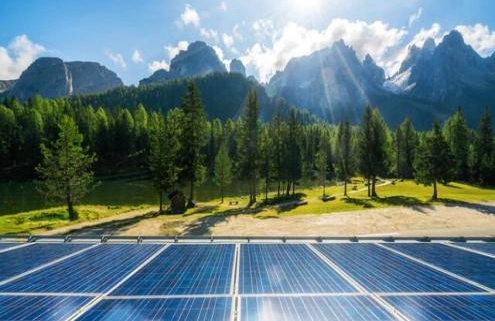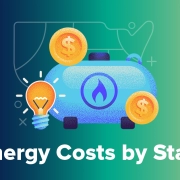How can sustainable solar energy solutions address energy security?
Sustainable solar energy solutions can diversify the energy mix and reduce reliance on centralized fossil fuel generation. By integrating distributed PV arrays on rooftops, carports, and community solar farms, regions worldwide can mitigate large-scale power outages caused by grid failures, extreme weather, or fuel supply disruptions. And some advanced sustainable solar energy solutions can also use smart inverters, dynamic voltage reactive power control, and real-time monitoring to provide grid support functions such as voltage regulation, reactive power compensation, and frequency stabilization. At the same time, the decentralized architecture in sustainable solar solutions relieves the pressure on aging transmission infrastructure and suppresses peak demand pressure by smoothing power supply fluctuations.
Achieving energy independence in remote areas through sustainable solar energy solutions
In some remote areas of the Middle East and Africa, it is often difficult to afford the high fuel transportation costs and maintenance. These microgrids are costly and unreliable and rely on diesel power generation. Then, in sustainable solar solutions, especially solar + energy storage microgrids, these energy vulnerabilities are addressed by replacing or supplementing diesel generators with PV arrays and modular battery systems. PV panels can capture the abundant sunlight in remote areas, while lithium-ion batteries can store excess energy at night or in bad weather. Intelligent controllers can manage the charge and discharge cycle, optimize the state of charge, and extend the battery life through thermal management and balanced battery charging. The result is a powerful off-grid power system capable of providing continuous power for telecommunications, pumping, refrigeration, and community lighting.

Reduce the impact of fuel price fluctuations
Energy security is closely related to price stability. Traditional power plants using natural gas, coal, or diesel are vulnerable to unpredictable market fluctuations such as geopolitics, supply chain disruptions, or regulatory changes. The use of a sustainable solar energy solution can hedge against such fluctuations. After installation, the marginal cost of generating electricity from solar arrays is almost zero, effectively decoupling electricity bills from volatile fossil fuel prices. Some companies and utilities can sign long-term power purchase agreements with fixed and transparent rates, allowing for better budgeting and financial forecasting.
In addition, the advantages of time-of-use electricity prices can be taken advantage of. During the peak solar energy period during the day, solar energy systems can offset the high electricity prices during peak hours, while stored solar energy can be released during the more expensive night hours, for large commercial and industrial consumers, predictable electricity expenditures, higher profit margins, and the ability to pass on cost savings to end users.
Indirectly enhance national security with sustainable solar energy solutions
Solar-rich countries can use sustainable solar energy solutions to reduce their dependence on imported fuels, indirectly enhancing strategic autonomy and national security. From PV manufacturing and inverter assembly to installation and maintenance, local companies can create jobs, promote technology transfer, and reduce vulnerability to global supply disruptions. At the same time, solar parks and regional microgrid construction programs supported by some governments can support critical defense infrastructure, telecommunications hubs, and emergency shelters, ensuring uninterrupted operation even in geopolitical tensions. In addition, responders or military personnel can quickly deploy portable solar trailers and inflatable photovoltaic modules to disaster areas or forward bases to provide instant power for communications, medical facilities, and field operations.

Promote grid modernization and digitization.
Some digital platforms, automatic distribution management systems, and the transition to sustainable solar solutions have promoted the overall grid modernization. Solar inverters with communication protocols enable real-time data exchange, remote diagnostics, and wireless firmware updates. These capabilities enable utilities to perform predictive maintenance on substations and feeders, detect anomalies such as phase imbalance or voltage sag, and dynamically balance loads between feeders to avoid overloads. In addition, distribution networks based on real-time solar generation data can enhance planning and scenario analysis for future solar and storage deployments. In summary, sustainable solar energy solution help build a smarter, more adaptable grid resilient to physical and cyber threats, improving energy security and operational efficiency.
Promote Economic Growth and Sustainable Development
In addition to technical and security benefits, sustainable solar solution promote sustainable economic growth and community development. Lower electricity costs in the industrial, agricultural, and commercial sectors can attract new investments and support energy-intensive manufacturing processes. In rural areas, solar irrigation and cold storage facilities can increase agricultural productivity and reduce post-harvest losses, contributing to food security. In addition, revenue streams from solar power generation can provide funding for local infrastructure projects, schools, and health clinics.
A Holistic Approach to Energy Security
Sustainable solar energy solutions offer a multifaceted approach to enhancing energy security and strategic resilience. Decentralizing power generation through distributed photovoltaic arrays, combining solar with battery storage systems, and modernizing the grid through digital control can reduce the risks associated with centralized infrastructure, fuel price fluctuations, and supply chain disruptions while bringing reliable electricity to remote areas.




